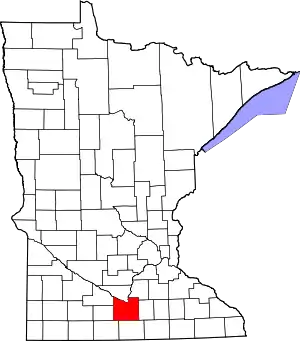Pemberton, Minnesota
Pemberton is a city in Blue Earth County, Minnesota, United States. The population was 247 at the 2010 census.[6] It is part of the Mankato–North Mankato Metropolitan Statistical Area.
Pemberton | |
|---|---|
| Nickname(s): The Pit | |
| Motto(s): "Where tomorrow begins today" | |
 Location of Pemberton, Minnesota | |
| Coordinates: 44°0′28″N 93°46′59″W | |
| Country | United States |
| State | Minnesota |
| County | Blue Earth |
| Government | |
| • Type | Mayor - Council |
| • Mayor | Douglas Baer |
| Area | |
| • Total | 0.19 sq mi (0.49 km2) |
| • Land | 0.19 sq mi (0.49 km2) |
| • Water | 0.00 sq mi (0.00 km2) |
| Elevation | 1,047 ft (319 m) |
| Population | |
| • Total | 247 |
| • Estimate (2019)[3] | 241 |
| • Density | 1,281.91/sq mi (495.57/km2) |
| Time zone | UTC-6 (Central (CST)) |
| • Summer (DST) | UTC-5 (CDT) |
| ZIP code | 56078 |
| Area code(s) | 507 |
| FIPS code | 27-50200[4] |
| GNIS feature ID | 0649254[5] |
Geography
According to the United States Census Bureau, the city has a total area of 0.18 square miles (0.47 km2), all of it land.[7]
Demographics
| Historical population | |||
|---|---|---|---|
| Census | Pop. | %± | |
| 1950 | 152 | — | |
| 1960 | 177 | 16.4% | |
| 1970 | 128 | −27.7% | |
| 1980 | 208 | 62.5% | |
| 1990 | 228 | 9.6% | |
| 2000 | 246 | 7.9% | |
| 2010 | 247 | 0.4% | |
| 2019 (est.) | 241 | [3] | −2.4% |
| U.S. Decennial Census[8] 2018 Estimate[9] | |||
2010 census
As of the census[2] of 2010, there were 247 people, 91 households, and 68 families living in the city. The population density was 1,372.2 inhabitants per square mile (529.8/km2). There were 98 housing units at an average density of 544.4 per square mile (210.2/km2). The racial makeup of the city was 98.0% White, 0.4% Asian, 1.2% from other races, and 0.4% from two or more races. Hispanic or Latino of any race were 3.2% of the population.
There were 91 households, of which 37.4% had children under the age of 18 living with them, 57.1% were married couples living together, 14.3% had a female householder with no husband present, 3.3% had a male householder with no wife present, and 25.3% were non-families. 19.8% of all households were made up of individuals, and 4.4% had someone living alone who was 65 years of age or older. The average household size was 2.71 and the average family size was 3.10.
The median age in the city was 33.4 years. 30.8% of residents were under the age of 18; 6.1% were between the ages of 18 and 24; 32% were from 25 to 44; 21.9% were from 45 to 64; and 9.3% were 65 years of age or older. The gender makeup of the city was 47.4% male and 52.6% female.
2000 census
As of the census[4] of 2000, there were 246 people, 84 households, and 64 families living in the city. The population density was 1,196.4 people per square mile (452.3/km2). There were 86 housing units at an average density of 418.2 per square mile (158.1/km2). The racial makeup of the city was 99.19% White, and 0.81% from two or more races.
There were 84 households, out of which 41.7% had children under the age of 18 living with them, 64.3% were married couples living together, 8.3% had a female householder with no husband present, and 23.8% were non-families. 19.0% of all households were made up of individuals, and 7.1% had someone living alone who was 65 years of age or older. The average household size was 2.93 and the average family size was 3.44.
In the city, the population was spread out, with 29.7% under the age of 18, 12.6% from 18 to 24, 30.1% from 25 to 44, 19.9% from 45 to 64, and 7.7% who were 65 years of age or older. The median age was 31 years. For every 100 females, there were 103.3 males. For every 100 females age 18 and over, there were 98.9 males.
The median income for a household in the city was $39,167, and the median income for a family was $42,222. Males had a median income of $25,714 versus $22,361 for females. The per capita income for the city was $17,640. None of the families and 4.1% of the population were living below the poverty line, including no under eighteens and 21.1% of those over 64.
References
- "2019 U.S. Gazetteer Files". United States Census Bureau. Retrieved July 26, 2020.
- "U.S. Census website". United States Census Bureau. Retrieved November 13, 2012.
- "Population and Housing Unit Estimates". United States Census Bureau. May 24, 2020. Retrieved May 27, 2020.
- "U.S. Census website". United States Census Bureau. Retrieved January 31, 2008.
- "US Board on Geographic Names". United States Geological Survey. October 25, 2007. Retrieved January 31, 2008.
- "2010 Census Redistricting Data (Public Law 94-171) Summary File". American FactFinder. United States Census Bureau. Retrieved April 27, 2011.
- "US Gazetteer files 2010". United States Census Bureau. Archived from the original on July 2, 2012. Retrieved November 13, 2012.
- "Census of Population and Housing". Census.gov. Retrieved June 4, 2015.
- "Population Estimates". United States Census Bureau. Retrieved July 5, 2019.

